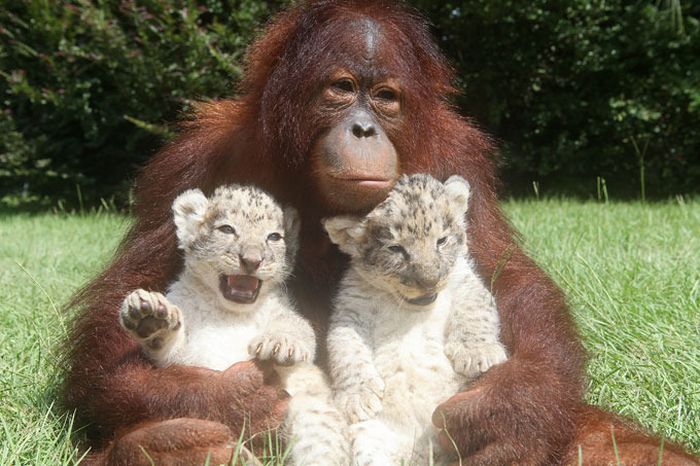Two Lion Cubs With Monkey
|
Hunting and diet
Lions are powerful animals that usually hunt in coordinated groups and stalk their chosen prey. However, they are not particularly known for their stamina—for instance, a lioness' heart makes up only 0.57 percent of her body weight (a male's is about 0.45 percent of his body weight), whereas a hyena's heart is close to 1 percent of its body weight. Thus, although lionesses can reach speeds of 81 km/h (50 mph), they only can do so for short bursts so they have to be close to their prey before starting the attack. They take advantage of factors that reduce visibility; many kills take place near some form of cover or at night. They sneak up to the victim until they reach a distance of approximately 30 metres (98 ft) or less. Typically, several lionesses work together and encircle the herd from different points. Once they have closed with a herd, they usually target the closest prey. The attack is short and powerful; they attempt to catch the victim with a fast rush and final leap. The prey usually is killed by strangulation, which can cause cerebral ischemia or asphyxia (which results in hypoxemic, or "general", hypoxia). The prey also may be killed by the lion enclosing the animal's mouth and nostrils in its jaws (which would also result in asphyxia). Smaller prey, though, may simply be killed by a swipe of a lion's paw.
The prey consists mainly of large mammals, with a preference for wildebeest, impalas, zebras, buffalo, and warthogs in Africa and nilgai, wild boar, and several deer species in India. Many other species are hunted, based on availability. Mainly this will include ungulates weighing between 50 and 300 kg (110–660 lb) such as kudu, hartebeest, gemsbok, and eland. Occasionally, they take relatively small species such as Thomson's Gazelle or springbok. Lions hunting in groups are capable of taking down most animals, even healthy adults, but in most parts of their range they rarely attack very large prey such as fully grown male giraffes due to the danger of injury.
Extensive statistics collected over various studies show that lions normally feed on mammals in the range 190–550 kg (420–1210 lb). In Africa, wildebeest rank at the top of preferred prey (making nearly half of the lion prey in the Serengeti) followed by zebra. Most adult hippopotamuses, rhinoceroses, elephants, and smaller gazelles, impala, and other agile antelopes are generally excluded. However giraffes and buffalos are often taken in certain regions. For instance, in Kruger National Park, giraffes are regularly hunted. In Manyara Park, Cape buffaloes constitute as much as 62% of the lion's diet, due to the high number density of buffaloes. Occasionally hippopotamus is also taken, but adult rhinoceroses are generally avoided. Even though smaller than 190 kg (420 lb), warthogs are often taken depending on availability. In some areas, they specialise in hunting atypical prey species; this is the case at the Savuti river, where they prey on elephants. Park guides in the area reported that the lions, driven by extreme hunger, started taking down baby elephants, and then moved on to adolescents and, occasionally, fully grown adults during the night when elephants' vision is poor. Lions also attack domestic livestock; in India cattle contribute significantly to their diet. They are capable of killing other predators such as leopards, cheetahs, hyenas, and wild dogs, though (unlike most felids) they seldom devour the competitors after killing them. They also scavenge animals either dead from natural causes (disease) or killed by other predators, and keep a constant lookout for circling vultures, being keenly aware that they indicate an animal dead or in distress. A lion may gorge itself and eat up to 30 kg (66 lb) in one sitting; if it is unable to consume all the kill it will rest for a few hours before consuming more. On a hot day, the pride may retreat to shade leaving a male or two to stand guard. An adult lioness requires an average of about 5 kg (11 lb) of meat per day, a male about 7 kg (15.4 lb).
|
|









